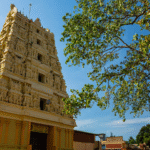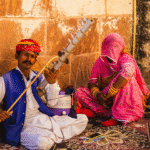
I looked outside my hotel window as I tried to soak in Ahmedabad. It was my third day here and I had already seen everything. I started googling and asking my friends who live in Gujarat, what more could I do. After hours of searching and talking I came across these absolutely off beat place called Patan. Patan is about 125km from Ahmedabad.
Patan is famous for its VAVs. VAVs are typically stepped wells that were used in yesteryears. They were areas of celebration and grandeur. This makes these step wells intricately engraved and detailed. The step wells are usually so detailed that every single minuscule artwork tells the tale of the talents that their marker possessed.
This step well in Patan is actually a world heritage site recognised by UNESCO. The picture of this step well can also be found in some of our currency notes. Imagine my shame when I didn’t know what it was till an extensive search led me to this place. This made me wonder how less we know if our history and how even less we do to promote the rich culture of the years gone by.

I reached Patan around 11 am. My taxi driver pointed me to an auto stand and asked me to take an auto to Rani ni Vav. Autos regularly ply to the site and usually only takes Rs. 30.
My auto driver was extremely nice and started lamenting as to how this beautiful step well hardly gets any visitors. I couldn’t agree with him more. He also told me that the VAV was created by Udayamati, the queen of the Solanki dynasty during Bhimdeva-1 rule.
This lovely place is perfect for history lovers, as it is filled with anecdotes through carvings and other visual aids. I, being a history student couldn’t wait to reach.
As I stepped into the complex, I realised it was much bigger than I had imagined it to be. There were pillars and monuments where ever my eyes went. It is about 64 metres long, 27 metres deep and 20 metres wide, making this one of the largest structures of that time.
I walked across the multi-storied pavilion as I tried to gauge the architectural brilliance that made this place so elegant and graceful. Every statue, every sculpture, and every craving has its purpose and tells a story. They sculptures of carved mahisasuramardini, Parvati and other Saiva sculptures, Vishnu in different forms, Bhairava, Ganesha, Surya, Kubera, Lakshminarayan, Ashtadikpalas, and other forms decorate the walls. The female figures have been depicted in various poses of Apsaras, Nagakanyas, Yoginis, etc.
I study the sculptures closely and started wondering if these artisans were so multi-talented that they have perfect knowledge about geometry, symmetry, and mathematics. The placements of the sculptures are so calculated and well positioned, that one cannot help but acknowledge that art and culture were at its best during that time. Even the lining of the well has such interesting carvings that it is a pity that one cannot go down to the bottom completely, because of the staggering depth.

One fascinating fact about this place was that, during the monsoons, the entire VAV starting from the top would get flooded. This made the site weaker in due course. However, the elegant sculpture of the Gods somehow bore the ravages of time, natural calamities and even attacks from the Islamic invaders and managed to stay strong and stood upright. These have now managed to survive more than a 1000 years. This is an amazing achievement and a testimony to the strength and dedication of the architects and engineers of those times. In the current areas even recently built bridges with more technology seems to collapse so frequently.
Around Rani ki VAV there are few other interesting things to explore. I would recommend the tombs of “Behram Khan” and “Shashtraling” among others.
After having such an extensive lesson in history and marvelling at the wonders, I decided to face lunch. There are some restaurants near Rani ni VAV which serve delicious and authentic Gujarati dishes.

After munching on to some delicacies I proceeded to a Patola saree manufacturing unit. My friend had arranged for a tour for me in this factory. I reached there a little after 3 pm and was welcomed extremely warmly. The Patola saree is a traditional saree was Gujarat that is beautifully made. The handiwork is amazing and the hard work is even better.
After a quick tour of all the weaving and printing machinery that a Patola saree requires, the manager of the facility explained to me how the saree is actually made.
The unique part of the saree is that it can be worn on both sides- its called a double weave. The manager chuckled that even the weavers are unable to identify which is the front and which is the back.
A Patola saree can take up to four to six months to make if three weavers are working on it. There are about 20 small and big processes that are included before the final product can see the daylight. It is said that a Patola saree can last up to 100 years and the colour doesn’t fade for 300 years. This is a saree that lasts for generations.

The process was so fascinating, and seeing a few of the workers engaged in the process made it extremely fun to watch. Due to this kind of back-breaking work, the saree is pretty expensive. It starts from 30000 INR to 150000 INR.
After the tour, I headed back to Ahmedabad, as my mind drifted off to the beautifully lost grandeur of Rani Ki Vav. I imagined myself getting lost in the innumerable cervices in the walls, and getting transported back to that the long lost time when the VAV was still used.

12 Beautiful Apple Orchard Destinations in India for a Scenic Mountain Getaway
28 Nov 2025
11 Ancient Temples in Palakkad Kerala for a Soulful Spiritual Journey
27 Nov 2025
100 Amazing Facts about Rajasthan That Prove Rajasthan Is Awesome!
27 Nov 2025
12 Best Destinations for Spiritual Trekking in the Himalayas
26 Nov 2025
Top 10 Beaches in Thailand to Have a Dream Vacation
25 Nov 2025